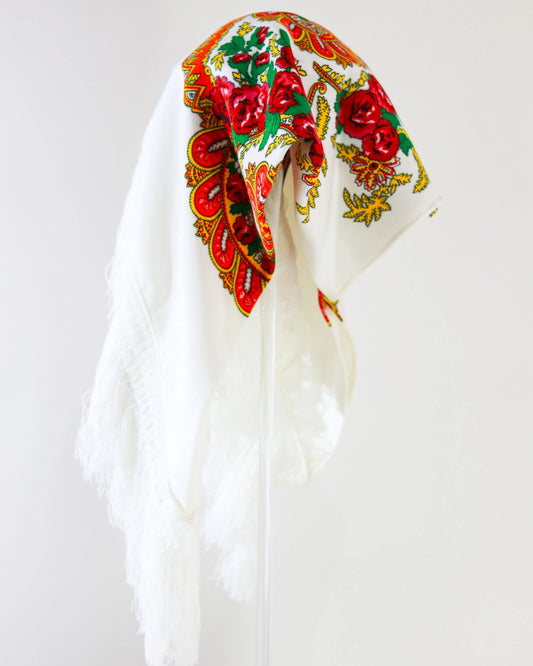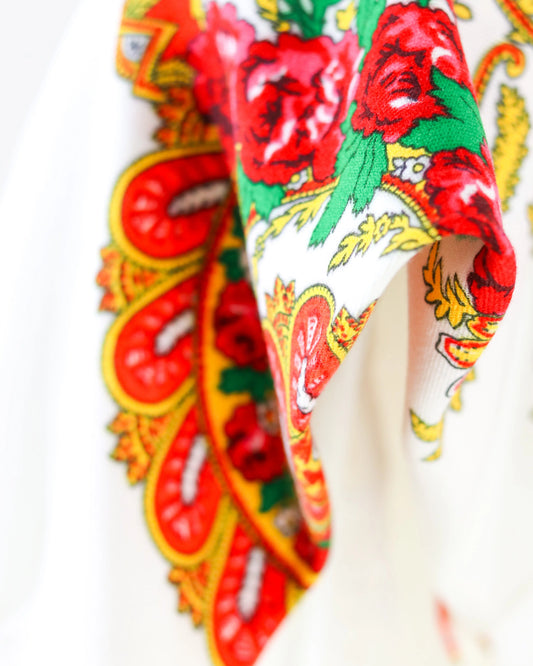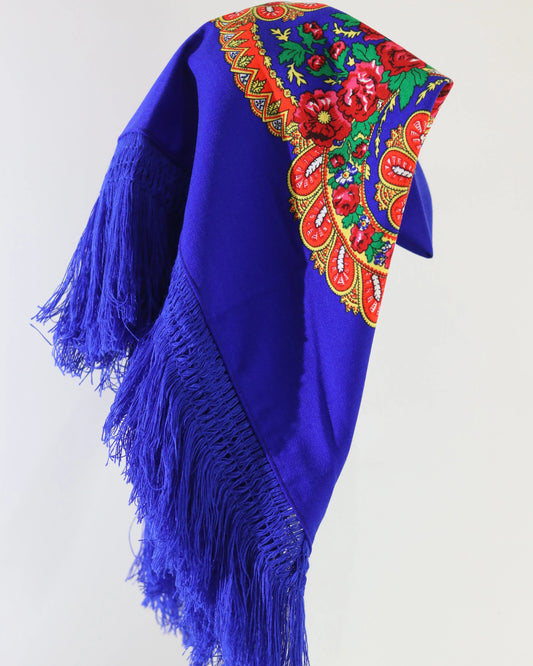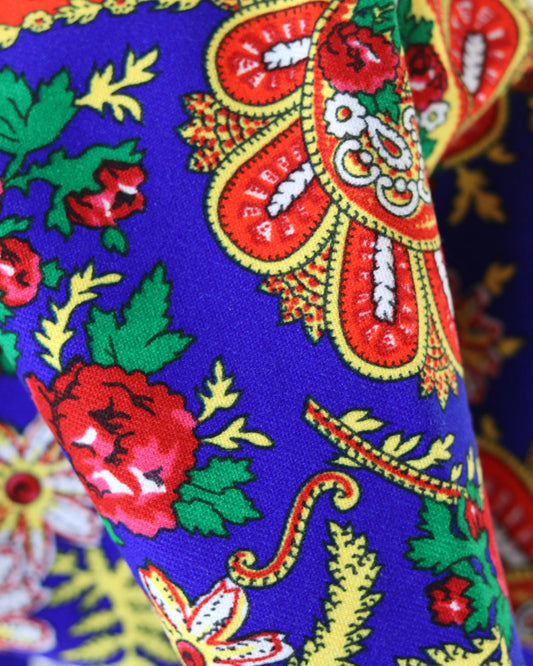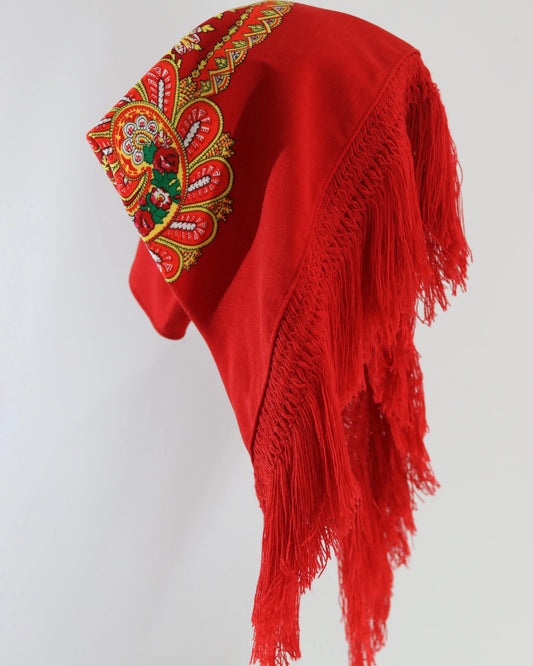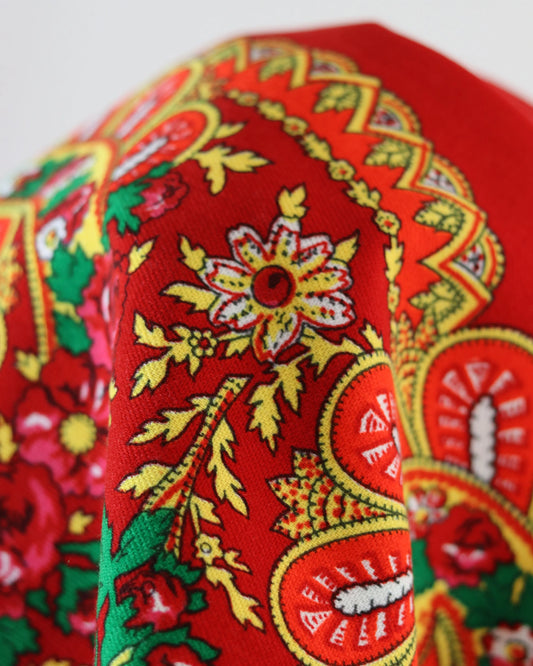Meaning of Viana scarves: tradition and culture
An entire city can be recognized by a detail of fabric. In Viana do Castelo , that detail is the scarf: sometimes red and vibrant, sometimes green with a regal memory, sometimes dark when life demands modesty. The scarf speaks without saying a word. It recounts loves, marks belongings, welcomes devotion, and marks the festive landscape of Alto Minho.
Their symbolic power wasn't born in a study. It was forged in the heads and chests of rural women, in the hustle and bustle of markets, and in pilgrimages that still draw crowds today. The more one looks, the more layers reveal themselves: material, color, design, gesture, occasion. It is in this combination that the meaning of Viana's scarves is illuminated.
Where they came from and how they became symbols
In the 19th century, the headscarf was a daily presence for women in Minho. In 1885, Ramalho Ortigão, astonished at the Viana market, noticed that no woman's head was without a headscarf. Many were a fiery red, the color of cactus flowers, but there were also molten blues, canary yellows, purples, and oranges. The palette seemed to have been harvested directly from the Lima River and the neighboring gardens.
For decades, chintz scarves preserved by the Royal Factory of Alcobaça were used. Then came the franjeiros, imported fine wool scarves, sometimes called Austrians. At the turn of the 20th century, a significant portion came from the famous Pavlovo Posad in Russia. What we now call the Viana scarf, therefore, has a history that crosses borders: refined foreign fabric serving a deeply local costume .
This dialogue between outside and inside was decisive. The fabric traveled, and meaning was created in Viana. And over time, the scarf became a symbol of Viana costume : an essential piece, along with gold , aprons, and linen vests.
Two close universes: franks and lovers' scarves
It is important to distinguish, without separating, two traditions that coexist in the region.
-
Fringe scarves: thin, with hanging fringes and printed or embroidered ornamental motifs. The stylized cornucopia stands out, surrounded by flowers and arabesques. They have become the most widespread image of the Viana scarf, especially in red.
-
Valentine's handkerchiefs: worlds apart, handcrafted, embroidered with cross-stitch. They feature hearts, birds, flowery bows, animals, saints, and above all, love verses with sincere, sometimes naive, spelling. They were given by the girl to the boy, who would wear them around his neck if he returned the affection.
In the first case, the ornament and festive elegance of the costume prevail. In the second, the intimacy of a message. Both share a root of affection and belong to the same Minho constellation.
Colors that speak of moods and geography
In the Viana scarf, color is not merely decorative. It communicates.
- Red: vitality, celebration, abundance. It is the most visible and widespread.
- Black and dark purple: sobriety, longing, circumstances of grief. This is not formal mourning, but it signals withdrawal.
- Canary yellow and orange: joy, energy. In some parishes, yellow is for the head and orange for the chest.
- Green: linked to Geraz do Lima, echoing the tribute to Queen Maria II and the monarchical color.
Each community has refined this palette in its own way. Costumes aren't uniform. They're territorial.
Featured local palettes
| Parish | Striking colors | Main use part | Local significance note |
|---|---|---|---|
| Areosa | Red | Head and chest | Associates red with the parish's identity |
| Afife | Yellow on the head, orange on the chest | Head and chest | Distinctive color combination |
| Santa Marta de Portuzelo | Red with yellow | Head and chest | Vivid contrast at a party |
| Geraz do Lima | Green | Head and chest | Symbolic heritage linked to D. Maria II |
| Set of C (various) | Dark blue and purple | Head | Serious tone, linked to sadness or longing |
The interpretation of color combines context, parish, and occasion. The same red can represent exaltation in a pilgrimage and solemnity in a festive mass.
Motifs and messages: what the drawings show
If color sets the tone, motifs provide the narrative. In the frangipani, the cornucopia dominates. It's the horn of plenty, folded into volutes, surrounded by flowers and baskets. Its outline can be more pointed in older examples or rounded in models popularized from the 1920s onward.
In lovers' handkerchiefs, the repertoire is intimate and symbolic.
- Hearts: union, promise, commitment.
- Birds: fidelity, the beloved's coming and going, hope in their return.
- Saints: protection and blessing of dating.
- Animals and flowering branches: fertility, continuity of the home.
- Verses: the most human thread, sewn with popular grace.
There are also small elements that escape the hurried eye: garlands, stars, discreet crosses, small keys that insinuate trust. Each stitch is an intention.
From everyday life to the Pilgrimage of Agony
The headscarf has lived on in everyday life and continues to reign supreme at festivals. Previously, every trip to the market required a headscarf. It was an indispensable accessory for ordinary women, so common it almost went unnoticed.
It dominates the festive calendar. In August , the Pilgrimage of Our Lady of Agony transforms Viana into a carpet of scarves. In the Procession of the Mordomia , hundreds of women in full regalia traverse the city, leaving a sea of red and fringes swaying in the air. It's devotion, it's pride, it's a conscious display of living heritage.
At weddings, folk dances , and family vows, the scarf continues to be found in and out of trunks and wardrobes. A gift for a romantic get-together, a gesture of peace, a keepsake from grandma.
Class, generation and change
The use of the scarf was socially marked. In villages and on skirts, it was practical and beautiful. In the city and the elite, it was worn mainly on formal occasions. With modernization, it ceased to be an everyday presence. It remained a memory in the older generations and an attentive curiosity in the younger ones.
Interestingly, the routine has been lost and symbolic significance has been gained. Today, the scarf is a symbol of a regional identity recognized as such, studied, presented, and cared for by museums, associations, and artisans.
Material and craft: what makes a good scarf
The quality is felt in the hand. Historically, scarves have been made from natural fibers: linen, fine wool, cotton, and, in more refined pieces, silk. Fringers demand a light drape and firm fringes. Embroidery requires proper thread tension, a balanced design, and a clean back.
The 20th century brought changes. There was a period of mass production, with cheap acrylic and less rigorous printing. At the same time, local collectors and producers sought to revive the old standard, even turning to the Russian factory that supplied Viana at the beginning of the last century. Today, the quality offering once again includes wool, cotton, and silk, with artisanal production reaching a few thousand pieces annually.
In embroidery schools and municipal workshops, students are taught the correct stitch, hoop selection, and patience in drawing. The learning hand imprints the shared memory on the fabric.
Who keeps the tradition
Safeguarding has become an institution. The Viana do Castelo Costume Museum researches, inventories, preserves, and exhibits costumes and their accessories. The municipality certified Viana do Castelo Embroidery, establishing standards, materials, and techniques. A specification book guides authenticity without restricting original diversity.
Folklore groups, regional houses, associations, and artisans form a mutually supportive network. Courses, exhibitions, public demonstrations, and workshops offer learning by doing. The public square, during festivals, also serves as a living museum.
Between tradition and fashion: tensions and balances
Visibility has its effects. Popularity has solidified a fringed model with a round cornucopia, much sought after by those who believe they are acquiring the quintessential pattern. This preference has reduced the existing variety, stifling pointed cornucopias and other 1900s designs.
Attentive artisans have responded with historic reissues and limited editions that revive forgotten designs. The global market demands scale, but the Viana community insists on material and graphic authenticity: natural fibers, faithful colors, designs that respect the local repertoire, and the correct technique.
The future hangs in this balance. And so far, it has been possible to reconcile the product's appeal with the wealth of assets.
How to Read a Handkerchief: A Quick Guide
- Touch: Fine wool and cotton have body and breathability. Acrylic reveals itself with its shine and texture.
- Fringe: must be well twisted, with a clean and strong finish.
- Color: Vivid saturation, without veering into harsh hues. Traditional red is warm and deep.
- Design: coherent cornucopias, flowers, and arabesques proportioned. On the lovers' handkerchiefs, careful reverse and regular stitches.
- Context: Ask about the parish, the occasion, and the model's period. A good salesperson knows how to tell the story of what they're selling.
Care and preserve
- Store in a dry, ventilated place, away from direct light.
- Fold with tissue paper between layers to avoid sharp creases.
- Hand wash in cold water with mild soap, do not wring. Dry flat.
- Avoid perfumes and sprays directly on the fabric.
- For antique pieces, prefer cleaning by professionals specialized in textiles.
Minimum itinerary in Viana to see and learn
- Costume Museum: collection, temporary exhibitions, technical documentation of costumes and scarves.
- Municipal Embroidery Workshop: introductory experience in traditional stitches.
- Artisan shops and workshops: comparing materials, communicating with producers, and custom orders.
- Romaria d'Agonia (August) : observation in motion of the complete costume and scarves in actual use.
Bring a notebook and write down colors, combinations, and usage gestures. Culture is best appreciated over time.
Economy and circulation: from Minho to the world
Viana's scarves have also become a cultural product. Craft shops, national fairs, international festivals, and online platforms put them in foreign hands. This circulation generates income, retains artisans, and sustains the continuity of workshops.
There's commerce, yes, but first there's reputation. Embroidery certification, museum curation, and participation in events with specific criteria define a level of quality that distinguishes tradition from mere imitation.
Frequently asked questions
-
Can a modern scarf be authentic? Yes, if you respect the materials, techniques, and design. Authenticity isn't synonymous with antiquity; it's fidelity to a specific skill.
-
Why are there so many variations of red? Dyeing, fiber, and season create different hues. Diversity is part of identity, as long as you don't lose your character.
-
Is the valentine's handkerchief only for dating? Today it's a popular art object, a family gift, a decorative item, and a collector's item. Its loving origins continue to resonate.
-
How to choose between fringe and embroidery? It depends on the use and taste. Fringe adds theatricality to the outfit. Embroidery offers intimacy and a unique voice.
What parties and everyday life say
The festival is the stage where the scarf shines, but its meaning arose in the work, on the way to the fields, on the way back from the market. It is this dual origin that gives it depth. The scarf is not just a piece of clothing. It is a cover for the hair, a sign of respect in church , and a form of order in clothing. Later, in the parade, it becomes a banner of belonging and joy.
What we see in Viana do Castelo is a city that has learned to understand and showcase its textile heritage. The scarf forms a larger picture with gold , linen, clogs, viras, folk dances , and devotions. The sound of the bass drums and the cadence of the steps bring it to life, and each waving fringe seems to beckon a story.
Between the river and the sea, a piece that remains
The colors of the scarves seem to draw luminosity and temperament from the Lima and the Atlantic. Red warms, green refreshes, yellow illuminates, purple pauses. When they land in museum windows or in home chests, they gain the silence of cherished objects. When they return to the streets, they once again become a shared language.
Anyone who arrives in Viana quickly realizes that the scarf is more than just an accessory. It's a way of saying: we're here, we've come from far away, we're still together. And as long as there are hands embroidering, eyes choosing the right color, and steps dancing, there will continue to be scarves that tell the story of Viana do Castelo with the delicacy of someone who knows how to say so much with so little fabric.

